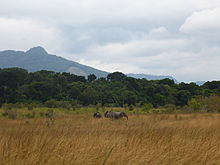Lopé National Park

Wasmannia auropunctata (fire ant) is an invasive alien species blamed for reducing species diversity, tree dweeling insects and eliminating arachnid populations.
| Lopé National Park | |
|---|---|
IUCN category II (national park) | |
 Panorama of the northern savannah dominated part Lopé National Park, shortly after the annual burning of thy grasses | |
| Location | Gabon |
| Coordinates | 0°30′00″S 11°30′00″E / 0.500°S 11.500°E / -0.500; 11.500Coordinates: 0°30′00″S 11°30′00″E / 0.500°S 11.500°E / -0.500; 11.500 |
| Area | 4,910 km2 (1,900 sq mi) |
| Established | 2002 |
| Governing body | National Agency for National Parks |
UNESCO World Heritage Site | |
| Official name | Ecosystem and Relict Cultural Landscape of Lopé-Okanda |
| Type | Mixed |
| Criteria | iii, iv, ix, x |
| Designated | 2007 (31st session) |
| Reference no. | 1147 |
| State Party | Gabon |
| Region | Africa |

View of Lopé and the Ogooué River.

A group of Forest elephants in the savannah of Lopé National Park.
Lopé National Park is a national park in central Gabon. Although the terrain is mostly rain forest, in the north the park contains the last remnants of grass savannas created in Central Africa during the last Ice Age, 15,000 years ago. It was the first protected area in Gabon when the Lopé-Okanda Wildlife Reserve was created in 1946. In 2007, the Lopé-Okanda landscape was added to the World Heritage List by UNESCO.
The park contains a small research station, named as Mikongo and run by the Zoological Society London, based in the village known as Mikongo, from which it gets its name. There exists infrastructure to cater for tourists at the base, including several chalets and a large open air dining room, from which the rainforest is a mere five meters away.[1] The park also hosts CEDAMM Training Centre, a Wildlife Conservation Society-run international conservation education center.
References
^ AP via Washington Post "UNESCO Committee Renames Auschwitz" 28 June 2007
External links
| Wikimedia Commons has media related to Lopé National Park. |
- Wildlife Conservation Society
- Virtual Tour of the National Parks
This Gabon location article is a stub. You can help Wikipedia by expanding it. |
This Africa protected areas related article is a stub. You can help Wikipedia by expanding it. |